Places Visited:
Wyoming: I-80 across southern Wyoming including
Rawlins, Laramie & Cheyenne
Nebraska: I-80 from the Wyoming border through
Sidney to the Junction with I-76
Colorado: US-385 from the Nebraska border
south through Burlington, Cheyenne Wells, and Lamar
August 14, RV-World
Campground 307-328-1891 Rawlins, Wyoming: N41° 46.980' W107° 16.345' $12.96
Full hookups with gravel interior roads and pads. Nice, clean park with a good
laundry and free wireless-----.
August 15, Cabela's RV-Park 308-254-7177
Sidney, Nebraska: N41° 6.951' W102° 57.494' $24.08 Full hookups with gravel
interior roads and pads. Nice, clean park with a good laundry located next door
to Cabela's home office and main store.
August 16, Country Acres RV-Park
308-254-7177 Lamar, Colorado: N38° 3.674' W102° 37.122' $21.00 Full hookups
with gravel interior roads and pads. Located next door to small motel--the only
RV-Park in area.
We have the motorhome on the move again continuing our
journey east and south.

Between
Pinedale and Rock Springs on US-191 we came across the spot where the Lander Cut
off on the old Emigrant Trail crossed the highway and wandered off to the horizon.
The Lander Cutoff also known as the northern fork of the Oregon Trail followed
a route of the fur traders. It was suggested as an Emigrant Road by Mountain Man
John Hockaday in order to avoid the alkali plains of the desert, shorten the trip
to the Pacific by five days, and provide more water, grass and wood. In 1857 it
was improved as a wagon road by the government under the supervision of F.W. Lander
and termed the Fort Kerney South Pass-Honey Lake Road. As many as 300-wagons and
thousands of cattle, horses and mules passed here each day. An expanding nation
moved with hope and high courage. The trail-cut deep into the dirt off the plains
and mountains and remains as a reminder of a great epoch.

Once
we reach Rock Springs and I-80 we begin to see the ubiquitous trains that accompany
I-80. West of Cheyenne trains comprised of containers fresh off Container Ships
unloaded at Pacific Coast ports is headed to the heartland.

East
of Rock Springs near Table Rock we traverse the Continental Divide and fall into
the Great Divide Basin.
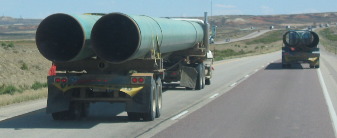
Trucks
hauling large steel pipes pass us on I-80 hurrying to some unknown job site.

Then
we spot that green pipe laying beside a job site that stretches to the horizon.

Miles
down the road we spotted these welding rigs each with a crane to position the
large pieces of pipe. While this picture only shows four of these rigs there were
many more stretched along the big gash that the welded pipe was being lowered
into. I suspect this is either a natural gas, petroleum or crude oil transport
line.

This
is typical terrain in the Great Divide Basin.

As
we neared Rawlins we came out of the Great Divide Basin and over the Continental
Divide for the second time today.

East
of Laramie we spotted these wind generators on a rise that appeared to stretch
across I-80. That wasn't the case. I-80 actually fell into a depression and abruptly
turned right to go around the bluff these wind generators were situated on.

This
wind generating field was actually 4 to 5 generators deep as can be seen from
this view from a different angle.
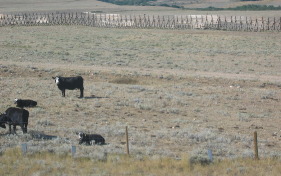
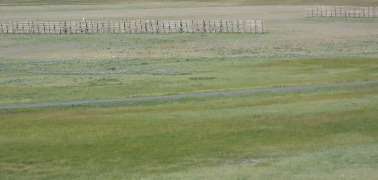
Eastern
Wyoming transitions from dry sage brush to a blush of green grass by the time
we reach the Nebraska border.
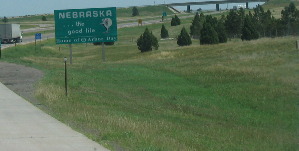
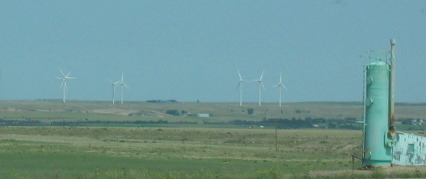
Nebraska
keeps trying to be greener still. By the time we get to Kimball, Nebraska even
more green grass is evident as are Kimballs' wind generating field.
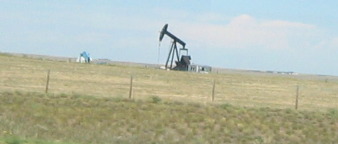
Kimball
also has a few oil wells.
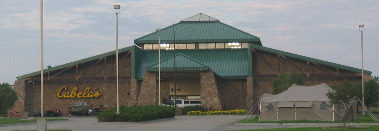
We
stopped for the night in Stanley, Nebraska home of Cabela's the famous outdoor
store. In fact we stayed in Cabela's RV-Park located adjacent to the Cabela's
Store and home office. Joyce and I wandered over to the Cabela's store mainly
to view their famous mounts and we weren't disappointed.
While we
saw diesel fuel for $3.99 in a small Wyoming town south of Jackson and one large
station in Jackson, Wyoming was advertising diesel for $3.69 the most we have
paid for diesel on this trip was $3.24 (advertised as $3.18 cash price). However,
we are about to turn south on US-385 through eastern Colorado where there is a
dearth of interstates and large to medium size cities thus a lack of truck stops.
We want to have a full tank of diesel before heading out so we swallowed hard
and topped off our tank with $3.42 diesel from a Shell station in Stanley.
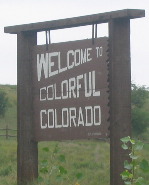

Eastern
Colorado is wide open spaces and large farms. Windmills seem to be a holdover
from a bygone era.

Windmills
turn an ordinary farm setting into a bucolic scene.
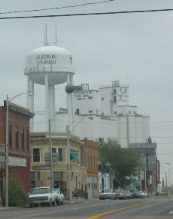
Julesburg,
Colorado is typical of eastern Colorado farm towns complete with huge grain elevators
along railroad tracks.

Corn
is the predominant crop we see in northeastern Colorado.
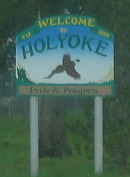

Holyoke
is one of the typical eastern Colorado towns scattered along US-385.
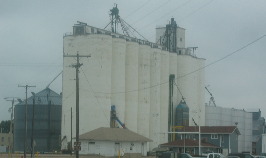
Grain
elevators are the common thread of all eastern Colorado towns.

This
place has hay even though we did not see much hay today.

Feed
lots such as this one are common, in eastern Colorado.

There were even several dairy operations such as this one.

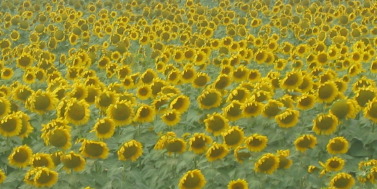
As
we drove south sunflower fields replaced corn as the predominant crop.

At
times sunflower fields would stretch from horizon to horizon.
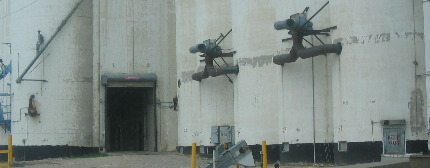
The
door where 18-wheelers drive through to deliver loads of grain seems so small
in comparison to the size of these grain elevators.

This
farmer had a serious operation. How many acres of grain would it take to fill
these bins?

The
smell emanating from feed lots such as these permeates the air for miles. I know
that those who depend on these operations for their income say it smells like
money--------. That isn't what is smells like to me.

Again,
feed lots are a common sight in eastern Colorado.

Sunflowers
from horizon to horizon.
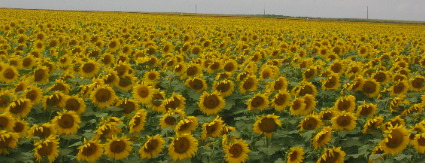

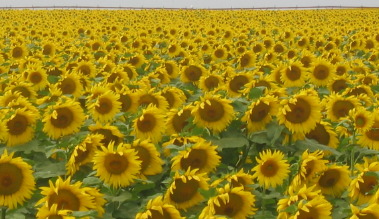
The
brilliance of these sunflower heads is simply stunning.
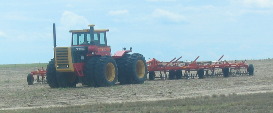
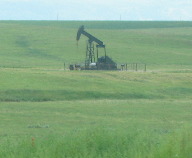
Tractors
and oil wells seem to compliment each other in eastern Colorado.

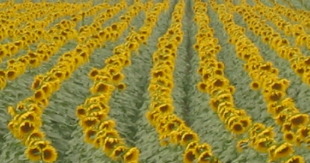
Huge
tractors are preparing ground for another crop presumably winter wheat. We are
fascinated with the rows upon rows of sunflowers all facing east.
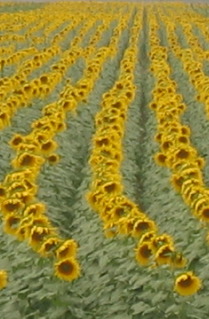
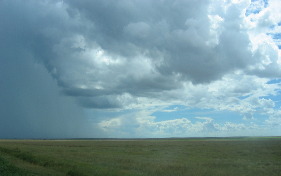
Why
are the sunflowers facing east when the sun is falling in the west? As we neared
Lamar, Colorado we watched a thunder storm race across the plain.
Until
next time remember how good life is.
Mike & Joyce Hendrix